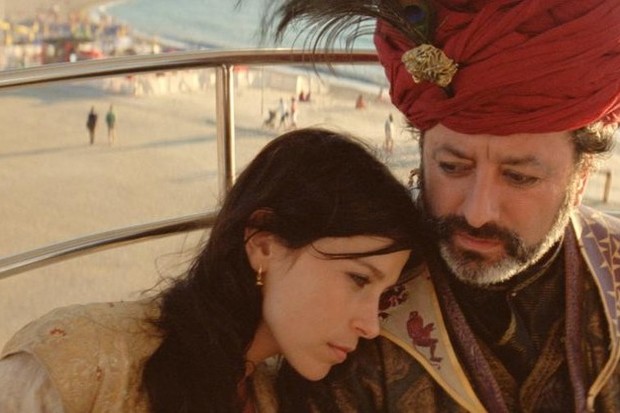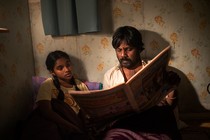CANNES 2015 Directors’ Fortnight
Arabian Nights, Volume 3: The Enchanted One: Scheherazade and the chaffinch keepers
- CANNES 2015: The spectacular journey with which Miguel Gomes has won over the Directors’ Fortnight ends like an ode to the people of Portugal, which turns from majestic to tender and moving

After the first two volumes of his Arabian Nights triptych, which, just as a reminder, comprise miscellaneous news items summing up the current poverty-stricken situation that Portugal finds itself in ("held to ransom by a policy of austerity characterised by the utter lack of a sense of social justice") but are narrated like absurd, sometimes allegorical, stories that are always very funny, Miguel Gomes has finally unveiled the beautiful Scheherazade (Crista Alfaiate) who had been promised, to the audience of the Directors’ Fortnight. After The Restless One [+see also:
film review
trailer
interview: Miguel Gomes
film profile] and then The Desolate One [+see also:
film review
trailer
interview: Miguel Gomes
film profile], a farandole of riotous nonsense that, in its final part, became extremely realistic, Arabian Nights – Volume 3, The Enchanted One [+see also:
trailer
interview: Miguel Gomes
film profile] kicks off with the graceful and lively movements of a dancer specialising in bharata natyam, an Indian art form, the essence of which – ie, telling a story – coincides perfectly with Gomes’ approach.
And so we step into this new chapter of the Gomesian saga at a relaxed pace, accompanied by the jingling of small, playful bells and shimmering flashes of splendid fabrics, in order to take a stroll with the wife who knew how to charm the cruel sultan in a spectacular Baghdad. It is colourful and echoes with a thousand legends and other tales – although we no longer know which of these are true and which are false, which belong to the past and which to the present, because the mischievous Portuguese director does not pass up the opportunity to play with both content and style, listing these tales one by one, while on the screen the story is played out in full. But don’t expect to find the silent register of Tabu [+see also:
film review
trailer
interview: Miguel Gomes
interview: Miguel Gomes
film profile] here: in The Enchanted One, the dances follow in the wake of the singing and the cheerful dialogues exchanged between the daughter of the vizier and her people, under a radiant sun, by a shimmering sea that, in a way, brings to mind Bahia, while very aptly, from the other side of the world, a US country singer recounts his saudade. We make the acquaintance of curious children who ask questions in French, and that of Paddleman (Carloto Cotta), a tremendous lothario, handsome as anything, and thick as two short planks... This chapter, which truly makes the fertile ground of the hieratic its own, is an astounding homage to Scheherazade's people, which must be interpreted as a response to the recommendation of her father, the great vizier, that she should be "mindful" of her children, as they are "the wonders of the world".
So back in Portugal, for the second part of the film, the focus falls on a small, quiet community that we enter through the intervention of Chico Chapas, who played gutless Simão, the bastard on the run from Volume 2 (who, as it happens, killed not only his wife but also his daughter), but this time around he plays himself – that is, a chaffinch keeper. "Forty years after the Carnation Revolution, a community of bewitched men devoted their lives to teaching their birds to sing," recalls Scheherazade, whose story continues to play out on screen. These aficionados, who apparently inherited their enthusiasm from a Flemish tradition and all live in the Lisbon shanty town of Boavista, do indeed devote all their energy to training chaffinches to be able to create the most warbles possible over a given length of time. These chaffinches have to "study" long and hard in order to achieve this goal, but when the owner manages to lead his bird all the way to victory, to “turn it inside out”, as they say (which can be done these days by creating birdsongs on computers and playing the mp3s to the bird), it is then enough to "warm up the chaffinch" so that it switches with ease from a "tatatachew" to a "rataratachew", which the best CDs can be made from. But achieving this requires a lot of care and attention, as well as that famous "mindfulness" that the vizier spoke of.
In Gomes’ world, this touching meticulousness becomes an expression of Portugal’s soul, of that beauty and that inner strength that enable it to continue moving forward, poor yet dignified, along the poppy fields, the sun-kissed vineyards, and even the Croisette...
The Arabian Nights triptych is a co-production between Portugal, France, Germany and Switzerland, and is sold internationally by The Match Factory.
(Translated from French)
Did you enjoy reading this article? Please subscribe to our newsletter to receive more stories like this directly in your inbox.























